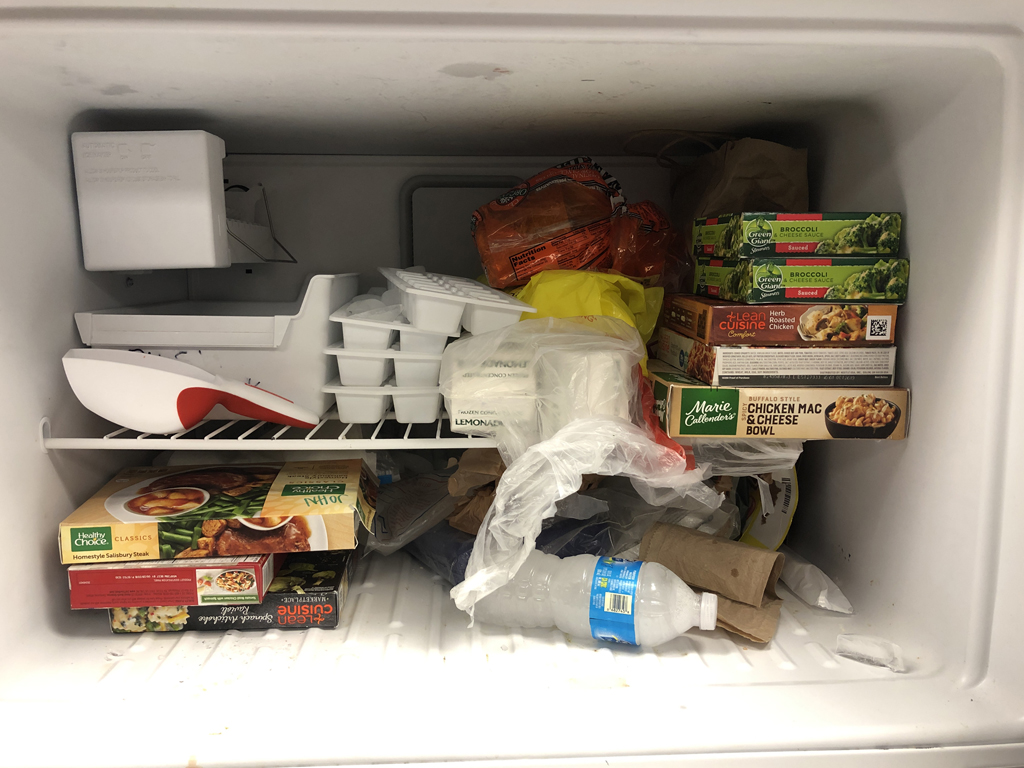
A freezer in good working order can keep food frozen as long as 48 hours, if it is packed to near capacity. This freezer could use a few more water bottles or blocks of ice to fill in some space. | Download this photo.
When the power goes out, keep a lid on food safety
Save what you can, toss the rest
Jan. 18, 2019
MANHATTAN, Kan. — When refrigerators and freezers suffer a loss of electrical power, the refrigerated and frozen foods inside can become susceptible to foodborne contaminants in just a few hours.
Severe weather events such as blizzards, thunderstorms and tornadoes can bring down power lines in a neighborhood, or even entire grids of a city. When the power goes out, the clock starts ticking on the viability of meats, seafood, ice cream, cut produce and even leftover pizza.
According to the USDA, bacteria such as E. coli, Salmonella, and Campylobacter can grow within minutes of food entering the “Danger Zone” – the range of temperatures between 40°F and 140°F. The insulation in freezers and refrigerators are your best allies during a power failure, as long as you don’t subvert them.
“One advantage of winter storms is that we often have 24 hours or more of advance warning,” said Londa Nwadike, a food safety specialist with K-State Research and Extension and the University of Missouri. “This allows you to take some pre-emptive steps to preserve your food.”
A refrigerator in good working order can maintain its temperature for about four hours; a full, reliable deep freezer can keep food frozen as long as 48 hours. Nwadike said there are small cheats that can help stretch your advantage.
- Share space with friends – If you have nearby friends and neighbors that have extra space in their freezer, consolidating frozen foods is a great strategy. “A full freezer will maintain its temperature longer than a freezer that’s only half full,” Nwadike said.
- Fill in the gaps – If you know a winter storm or blizzard is on the way, consider moving as much as possible from the refrigerator to the freezer. Leftover pot roast, tuna casserole, and plastic bottles of fruit juice will keep these foods in a colder environment, and helps fill empty spaces in the freezer. “You can also use water bottles, plastic gallon jugs of water, plastic storage containers filled with water,” Nwadike said. “Just get them frozen before the power goes out. If you have a source for dry ice (sometimes found in grocery stores), consider adding a few blocks to your freezer. Dry ice can extend your safe zone by several hours.
- Keep ’em shut!– As much as you can, Nwadike said, keep the doors closed. “Don’t open them to peek in and check to see what the temperature is – just leave them closed. Avoid that temptation.”
Refrigerator and freezer-rated thermometers are also a good permanent addition to your appliances. Nwadike says they’re inexpensive and will give you a reading the first time you open the appliance, after the power has been restored, and are important to use anytime.
After that, the question is simple: Keep it or toss it?
The USDA provides a handy, printable chart detailing which foods are most vulnerable (meats, seafood, dairy, ice cream) and which are a bit more stable (whole fruits and vegetables, condiments, hard block cheese). When checking the freezer, Nwadike said ice can be a good indicator.
“If an item is still frozen solid, or if you can still feel ice crystals, that’s a good thing,” Nwadike said. “But whatever you do, don’t taste something and think, ‘Well, if it tastes OK, it’s still good.’ Bacteria doesn’t always reveal itself that way.”
The oft-repeated adage holds true: When in doubt, throw it out.
Some homeowners insurance providers will cover a certain amount of food loss that results from a power outage. Nwadike advises homeowners to check with their insurance providers to find out what is covered, and what kind of documentation will be required to make a claim.
Even if the loss of food creates a financial hardship, it pales in comparison to the risks of consuming unsafe, contaminated food. Some foodborne illnesses can result in a costly hospital stay, if not death.
For more information and helpful tips, visit the Prepare Kansas blog, dedicated to anticipating and preparing for natural disasters and the K-State Research and Extension Food Safety disasters website.

